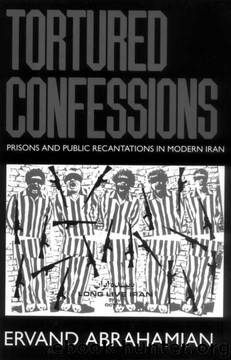Tortured Confessions: Prisons and Public Recantations in Modern Iran by Ervand Abrahamian

Author:Ervand Abrahamian [Abrahamian, Ervand]
Language: eng
Format: epub
Published: 2010-02-05T17:32:00+00:00
Stage Preparations
By late 1981, the prison wardens had put in place a routine procedure for interrogating incoming inmates. If not overly pressured for time, they placed them in solitary cells and, providing them with paper, ballpoint, and sometimes printed questionnaires, sought information on relatives, friends, and neighbors, as well as on their own lives and political leanings. Their key question here as well as later was: "Are you willing to give us an interview [mosahebeh]?"
After the initial interrogation, the prisoner would be taken to the taz`ir chambers for fuller confessions of crimes-real or imagined-and, most important of all, videotaped interviews. Constraints of time and solitary cells sometimes necessitated the skipping of the initial stage. If the interrogator in the ta`zir chamber was a mere layman, he would have telephone contact with clerical magistrates authorized to mete out discretionary punishments .31 The issue of mosahebeh would be raised persistently throughout the whole procedure-not only by the interrogator, but also by the prosecutor, by the trial judge, and by the warden once the prisoner had completed the sentence. Some remained incarcerated even after serving their sentences simply because they declined the honor of being interviewed. One prisoner reports that his trial judge put aside his file and simply asked, "Are you willing to be interviewed?"32 Another reports that the condemned were sometimes offered a reprieve if they provided the interview.33 Yet another says that in the ta'zir chamber his interrogator kept on repeating throughout his torment, "This hadd punishment will continue until you give us a videotaped interview."34
The techniques used in the ta`zir chambers resembled those of SAVAK. They included whipping, sometimes of the back but most often of the feet with the body tied on an iron bed; the qapani; deprivation of sleep; suspension from ceilings and high walls; twisting of forearms until they broke; crushing of hands and fingers between metal presses; insertion of sharp instruments under the fingernails; cigarette burns; submersion under water; standing in one place for hours on end; mock executions; and physical threats against family members. Of these, the most prevalent was the whipping of soles, obviously because it was explicitly sanctioned by the sharia.
The torture techniques included two innovations: the "coffin" and the compulsory watching of-and even participation in-executions. Some were placed in small cubicles, blindfolded and in absolute silence, for seventeen-hour stretches with two fifteen-minute breaks for eating and going to the toilet. These stints could last months-until the prisoner agreed to the interview. Few avoided the interview and also remained sane. Others were forced to join firing squads and remove dead bodies. When they returned to their cells with blood dripping from their hands, their roommates surmised what had transpired. In the summer, newcomers to Evin-including women-had to pass the main courtyard and view rows of hanged prisoners.35
The new interrogators differed from their predecessors in other subtle ways. Contrary to common belief, they avoided sexual organs. They shied away from the iron helmet, the metal prod, and the electrified chair; such mechanical devices were deemed too Western.
Download
This site does not store any files on its server. We only index and link to content provided by other sites. Please contact the content providers to delete copyright contents if any and email us, we'll remove relevant links or contents immediately.
| Africa | Americas |
| Arctic & Antarctica | Asia |
| Australia & Oceania | Europe |
| Middle East | Russia |
| United States | World |
| Ancient Civilizations | Military |
| Historical Study & Educational Resources |
Empire of the Sikhs by Patwant Singh(22762)
The Wind in My Hair by Masih Alinejad(4839)
The Templars by Dan Jones(4556)
Rise and Kill First by Ronen Bergman(4543)
The Rape of Nanking by Iris Chang(4022)
12 Strong by Doug Stanton(3418)
Blood and Sand by Alex Von Tunzelmann(3055)
The History of Jihad: From Muhammad to ISIS by Spencer Robert(2504)
Babylon's Ark by Lawrence Anthony(2427)
The Turkish Psychedelic Explosion by Daniel Spicer(2245)
No Room for Small Dreams by Shimon Peres(2235)
Gideon's Spies: The Secret History of the Mossad by Gordon Thomas(2230)
Inside the Middle East by Avi Melamed(2230)
Arabs by Eugene Rogan(2193)
The First Muslim The Story of Muhammad by Lesley Hazleton(2153)
Bus on Jaffa Road by Mike Kelly(2034)
Come, Tell Me How You Live by Mallowan Agatha Christie(2024)
Kabul 1841-42: Battle Story by Edmund Yorke(1921)
1453 by Roger Crowley(1879)
